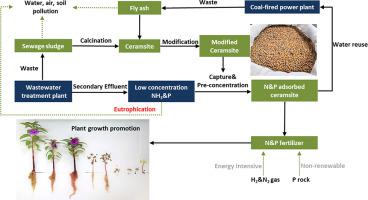Science of the Total Environment ( IF 8.2 ) Pub Date : 2021-09-11 , DOI: 10.1016/j.scitotenv.2021.150288 Qing Shao 1 , Ying Zhang 1 , Zhe Liu 2 , Lizhi Long 3 , Zizheng Liu 1 , Yiqun Chen 1 , Xin-Ming Hu 4 , Mingming Lu 5 , Li-Zhi Huang 6

|
Recovery of the nitrogen (N) and phosphorus (P) in wastewater would help to minimize eutrophication and their reuse would lead to a more sustainable society. Sewage sludge and fly ash were used to fabricate ceramsite in the laboratory. After modified with alkali or lanthanum it was shown in benchtop experiments to effectively recover N and P from real wastewater treatment plant effluent. The N&P-adsorbed ceramsite was then applied as an eco-friendly, slow-release fertilizer to promote the germination, growth and blooming of Impatiens commelinoides, realizing the recycling of N and P from wastewater. Emergy analysis shows that such recycling is more sustainable than the current two approaches (i.e., landfill and incineration) for sludge disposal. This work thus demonstrates a sustainable solution combining the reuse of solid waste, effective wastewater purification and recovery of N and P nutrients. Applying the technologies demonstrated would help to minimize the environmental impact of wastewater and solid waste.
中文翻译:

陶粒从废水中回收磷和氮:吸附机制、植物栽培和可持续性分析
回收废水中的氮 (N) 和磷 (P) 将有助于最大程度地减少富营养化,它们的再利用将导致更可持续的社会。实验室用污水污泥和粉煤灰制造陶粒。用碱或镧改性后,台式实验表明它可以有效地从实际污水处理厂出水中回收 N 和 P。将吸附氮磷的陶粒作为环保缓释肥料,促进凤仙花的萌发、生长和开花,实现废水中氮磷的回收利用。能值分析表明,这种回收利用比目前两种污泥处理方法(即填埋和焚烧)更具可持续性。因此,这项工作展示了一种结合固体废物再利用的可持续解决方案,有效的废水净化和 N 和 P 营养物质的回收。应用所展示的技术将有助于最大限度地减少废水和固体废物对环境的影响。











































 京公网安备 11010802027423号
京公网安备 11010802027423号